Family name: Asphodelaceae Juss.
Synonym(s): Aloaceae Batsch; Dianellaceae Salisb.; Geitonoplesiaceae R. Dahlgren ex Conran; Hemerocallidaceae R. Br.; Johnsoniaceae Lotsy; Phormiaceae J. Agardh; Xanthorrhoeaceae Dumort., nom. cons.
Common name(s): asphodel family
*Number of genera/species: 39/900
List of genera records in GRIN-Global
fruit or seed
Fruit dehiscentdehiscent:
(v. dehisce) splitting open at maturity to release contents (of a fruit)
 , loculicidalloculicidal:
, loculicidalloculicidal:
type of capsular dehiscence, opening longitudinally through the locules (compare septicidal)
 or fissuricidal capsulecapsule:
or fissuricidal capsulecapsule:
a dry, dehiscent fruit formed by two or more carpels
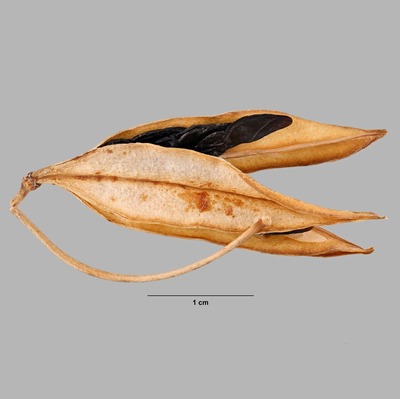 , rarely schizocarpschizocarp:
, rarely schizocarpschizocarp:
fruit formed from a single ovary, with fused carpels, with or without accessory tissue; splitting between locules to form distinct, indehiscent, usually one seeded segments; usually dry, rarely fleshy (compare mericarp)
 (1–3 single-seeded mericarps) or indehiscentindehiscent:
(1–3 single-seeded mericarps) or indehiscentindehiscent:
not opening on its own, as in a fruit
 , berryberry:
, berryberry:
an indehiscent, fleshy fruit with one or a few to many seeds. The flesh may be homogenous throughout. Or, if the outer part is hard, firm, or leathery, referred to as an hesperidium. Septa are present in some, and the seeds may be arillate or with a fleshy testa. (some Aloe, Dianella), 1–40 mm long, globoseglobose:
(some Aloe, Dianella), 1–40 mm long, globoseglobose:
3D shape—more or less spherical
 to angledangled:
to angledangled:
2D shape—having sides that meet at acute or obtuse angles
, usually angledangled:
2D shape—having sides that meet at acute or obtuse angles
in transectiontransection:
a cross section; representing a plane made by cutting across an organ at a right angle to its length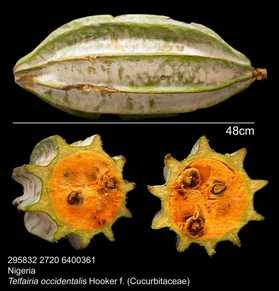 , sometimes with persistent bracts or stylesstyles:
, sometimes with persistent bracts or stylesstyles:
in a flower, the narrow and elongated part of the pistil between the stigma and the ovary; sometimes persisting in fruit
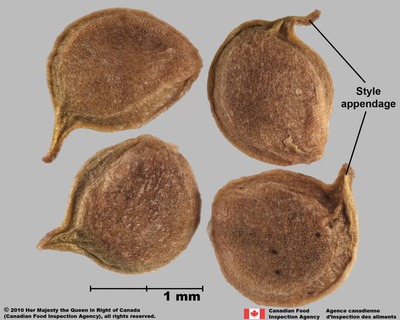 (capsule). Pericarppericarp:
(capsule). Pericarppericarp:
fruit wall or fruit coat
brown, yellow, green, gray, or sometimes blue (some Dianella), shinyshiny:
uniformly reflecting a high proportion of incident light at all angles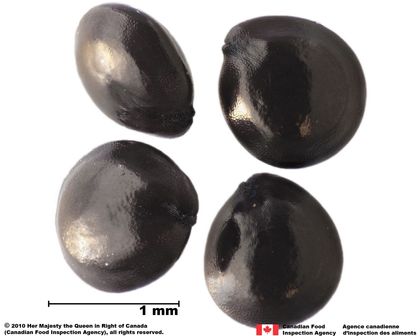 or dulldull:
or dulldull:
reflecting only a low proportion of incident light, with no apparent sheen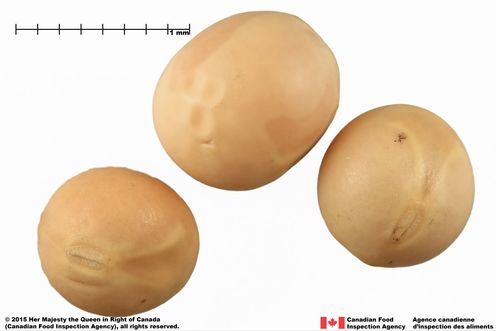 , usually thickthick:
, usually thickthick:
having or being of relatively great depth
walled – woodywoody:
consisting mainly of indurate lignified tissues, characteristic of or resembling wood
or fleshyfleshy:
texture—fairly firm and dense, juicy or at least moist, and easily cut
, sometimes membranousmembranous:
texture—extremely thin, pliable, and fairly tough
, smooth or variously sculptured, rarely pubescentpubescent:
surface relief—bearing hairs
or glandularglandular:
surface relief—covered with small, raised secretory glands, regular or irregularly shaped, translucent or opaque, and maybe distinctly colored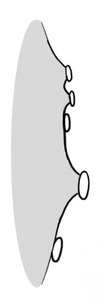 . In Kingia and Calectasia, fruits are achenesachenes:
. In Kingia and Calectasia, fruits are achenesachenes:
a dry, indehiscent, one-seeded fruit, with seed attached to pericarp at a single point
 within persistent perianthsperianths:
within persistent perianthsperianths:
collective term for calyx and corolla of a flower
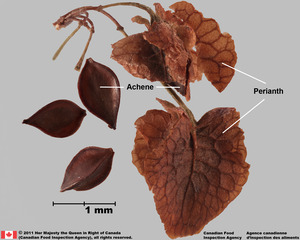 .
.
Seed variously shaped, often angledangled:
2D shape—having sides that meet at acute or obtuse angles
, tereteterete:
approximately circular in cross section; width and thickness approximately equal
 to flattened in transectiontransection:
to flattened in transectiontransection:
a cross section; representing a plane made by cutting across an organ at a right angle to its length , 1–16 mm long, and often arillate. ArilsArils:
, 1–16 mm long, and often arillate. ArilsArils:
(broad sense) appendicular structure that wholly or partly envelops a seed and is produced from or a modification of the funicle, raphe, or outer integument; usually fleshy or pulpy, sometimes spongy or tufted-capillate, often brightly colored
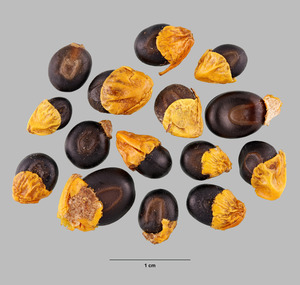 develop at the funiculusfuniculus:
develop at the funiculusfuniculus:
(alt. funicle) stalk connecting the ovule (later seed) to the ovary (later fruit) placenta
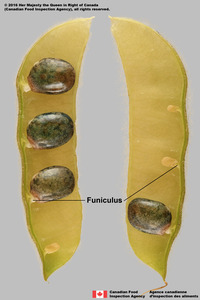 and more or less cover the seeds. The degree of development and thickness of the arilaril:
and more or less cover the seeds. The degree of development and thickness of the arilaril:
(broad sense) appendicular structure that wholly or partly envelops a seed and is produced from or a modification of the funicle, raphe, or outer integument; usually fleshy or pulpy, sometimes spongy or tufted-capillate, often brightly colored
 varies by genus. Seed coat black, brown, or gray, shinyshiny:
varies by genus. Seed coat black, brown, or gray, shinyshiny:
uniformly reflecting a high proportion of incident light at all angles or dulldull:
or dulldull:
reflecting only a low proportion of incident light, with no apparent sheen , crustaceouscrustaceous:
, crustaceouscrustaceous:
texture—thin, dry, indurate, and brittle
layer of black phytomelanphytomelan:
carbonaceous, opaque material that usually covers the seed coat to give it a black appearance, common in certain monocot families
, smooth or granulargranular:
surface relief—having a grainy surface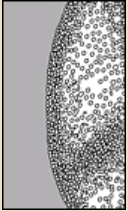 , wrinkledwrinkled:
, wrinkledwrinkled:
surface relief—shallow, irregular folds and furrows covering the surface; appearing overall though crumpled and then spread out , striatestriate:
, striatestriate:
surface relief—having fine, parallel lines, grooves or ridges , colliculatecolliculate:
, colliculatecolliculate:
surface relief—covered with small, round projections, similar to blistered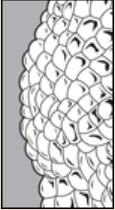 , or glandularglandular:
, or glandularglandular:
surface relief—covered with small, raised secretory glands, regular or irregularly shaped, translucent or opaque, and maybe distinctly colored . In genera formally placed in Aloaceae (Aloe, Astroloba, Chortolirion, Gasteria, Haworthia, Kniphofia, Poellnitzia), one membranaceousmembranaceous:
. In genera formally placed in Aloaceae (Aloe, Astroloba, Chortolirion, Gasteria, Haworthia, Kniphofia, Poellnitzia), one membranaceousmembranaceous:
texture—extremely thin, pliable, and fairly tough
wing encompasses a flat seed. In Phormium, flattened seeds appear winged.
Embryo well developed, axileaxile:
on or of the axis
and centric or basalbasal:
at or pertaining to the point of attachment; (of embryo) embryo occupies one end of the seed
position, foliatefoliate:
appearing leaf-like
or linearlinear:
(shape) long, narrow, and uniform in width; (of embryo) embryo is straight and much longer than wide
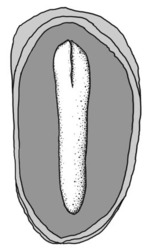 , straight or curvedcurved:
, straight or curvedcurved:
(of embryo) linear embryo is curved into an arch or horseshoe with the ends far apart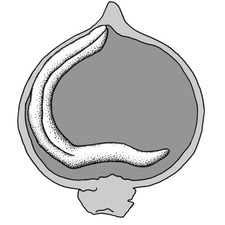 , embedded in endospermendosperm:
, embedded in endospermendosperm:
nutritive starch- and oil-containing tissue present in many seeds
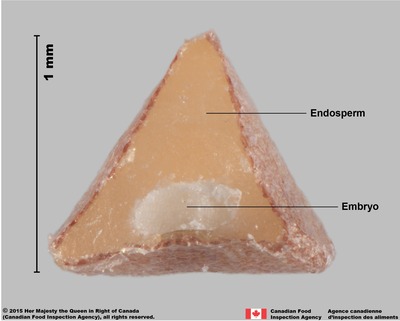 . Endospermendosperm:
. Endospermendosperm:
nutritive starch- and oil-containing tissue present in many seeds
 copious, cartilaginouscartilaginous:
copious, cartilaginouscartilaginous:
texture—firm, dense, tough, somewhat pliable, and resilient, like cartilage
, hard, or fleshyfleshy:
texture—fairly firm and dense, juicy or at least moist, and easily cut
.
| Fruit | |
| Type | loculicidal loculicidal: type of capsular dehiscence, opening longitudinally through the locules (compare septicidal)  or fissuricidal capsulecapsule: or fissuricidal capsulecapsule:a dry, dehiscent fruit formed by two or more carpels  , rarely schizocarpschizocarp: , rarely schizocarpschizocarp:fruit formed from a single ovary, with fused carpels, with or without accessory tissue; splitting between locules to form distinct, indehiscent, usually one seeded segments; usually dry, rarely fleshy (compare mericarp)  or berry or berry |
| Size range | 1–40 mm long |
| Shape(s) | globose, ovoidovoid: 3D shape—ovate  , oblongoblong: , oblongoblong:2D shape—much longer than broad with nearly parallel sides, corners are rounded  , ellipsoidellipsoid: , ellipsoidellipsoid:3D shape—elliptic , trigonoustrigonous: 3D shape—having three faces that meet at distinct angles; triangular in outline , cuneiformcuneiform: =wedge-shaped , fusiformfusiform: spindle-shaped; broadest at the middle and tapering at both ends 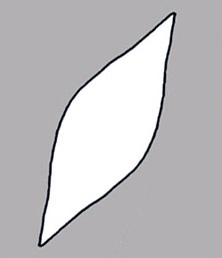 , teardrop-shaped , teardrop-shaped |
| Texture | membranaceous, woodywoody: consisting mainly of indurate lignified tissues, characteristic of or resembling wood , fleshy |
| Surface relief | smooth or wartywarty: surface relief—distinct, rounded projections that are large relative to the fruit size; tuberculate, verrucose 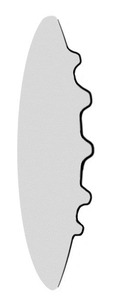 , wrinkledwrinkled: , wrinkledwrinkled:surface relief—shallow, irregular folds and furrows covering the surface; appearing overall though crumpled and then spread out  , ribbedribbed: , ribbedribbed:surface relief—wide, prominent, linear ridges that are generally rounded and longitudinally situated on the surface 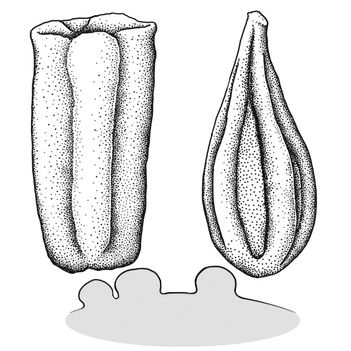 , glandularglandular: , glandularglandular:surface relief—covered with small, raised secretory glands, regular or irregularly shaped, translucent or opaque, and maybe distinctly colored  , reticulate , reticulate |
| Color(s) | brown, blue, black, yellow, gray, green |
| Unique features | Usually small capsulescapsule: a dry, dehiscent fruit formed by two or more carpels  (or berriesberry: (or berriesberry:an indehiscent, fleshy fruit with one or a few to many seeds. The flesh may be homogenous throughout. Or, if the outer part is hard, firm, or leathery, referred to as an hesperidium. Septa are present in some, and the seeds may be arillate or with a fleshy testa.  ) often with arillate, phytomelanphytomelan: ) often with arillate, phytomelanphytomelan:carbonaceous, opaque material that usually covers the seed coat to give it a black appearance, common in certain monocot families encrusted seeds. |
| Seed | |
| Size range | 1–16 mm long |
| Shape(s) | globose, ovoidovoid: 3D shape—ovate  , reniformreniform: , reniformreniform:2D or 3D shape—kidney-shaped  , triangulartriangular: , triangulartriangular:2D shape—three relatively straight sides with distinct corners; more angular than teardrop-shaped  , lens-shaped , lens-shaped |
| Surface relief | smooth, granulargranular: surface relief—having a grainy surface  , wrinkledwrinkled: , wrinkledwrinkled:surface relief—shallow, irregular folds and furrows covering the surface; appearing overall though crumpled and then spread out  , striatestriate: , striatestriate:surface relief—having fine, parallel lines, grooves or ridges  , colliculatecolliculate: , colliculatecolliculate:surface relief—covered with small, round projections, similar to blistered  , glandularglandular: , glandularglandular:surface relief—covered with small, raised secretory glands, regular or irregularly shaped, translucent or opaque, and maybe distinctly colored  ; crustaceouscrustaceous: ; crustaceouscrustaceous:texture—thin, dry, indurate, and brittle (phytomelan present) |
| Color(s) | black, brown, gray |
| Unique features | Phytomelan phytomelan: carbonaceous, opaque material that usually covers the seed coat to give it a black appearance, common in certain monocot families encrusted seeds, often arillate, sometimes winged. |
| Other | |
| Embryo | transverse transverse: lying, situated, or placed across to seed length, foliatefoliate: appearing leaf-like or linearlinear: (shape) long, narrow, and uniform in width; (of embryo) embryo is straight and much longer than wide  , cotyledoncotyledon: , cotyledoncotyledon:a primary leaf of the embryo 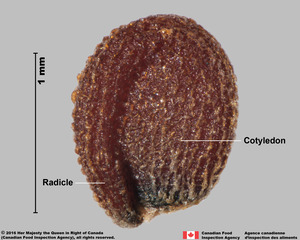 circinately coiled circinately coiled |
| Nutritive tissuenutritive tissue: tissue within the seeds that nourishes the developing embryo; such as endosperm, perisperm, or chalazosperm in angiosperms; megagametophyte in gymnosperms |
endosperm endosperm: nutritive starch- and oil-containing tissue present in many seeds  copious, cartilaginouscartilaginous: copious, cartilaginouscartilaginous:texture—firm, dense, tough, somewhat pliable, and resilient, like cartilage , hard or fleshy |
Temperate and tropical regions of Eurasia, Africa, Madagascar, Pacific Islands, and Australia. Also present in western South America.
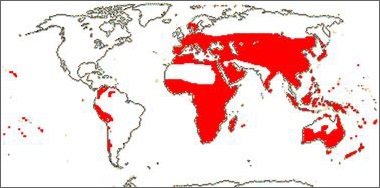
Distribution map courtesy of Angiosperm Phylogeny Website.
Baskin and Baskin 2021Baskin and Baskin 2021:
Baskin C and Baskin J. 2021. Relationship of the lateral embryo (in grasses) to other monocot embryos: A status up-grade. Seed Science Research 31 (3): 199-210. doi:10.1017/S0960258521000209; Bingham et al. 2021; Carter 1994Carter 1994:
Carter S. 1994. Aloaceae. In: Polhill RM, ed. Flora of Tropical East Africa. Vol 4b. AA Balkema, Rotterdam Netherlands. 60 pp.; Dahlgren et al. 1985Dahlgren et al. 1985:
Dahlgren RMT, Clifford HT, and Yeo PF. 1985. The families of the monocotyledons: structure, evolution, and taxonomy. Springer-Verlag, Berlin. 520 pp.; Flora of Australia 2021+Flora of Australia 2021+:
Flora of Australia. Australian Biological Resources Study, Canberra. Accessed January-May 2021. URL: http://www.ausflora.org.au; Flora of North America Editorial Committee 1993+Flora of North America Editorial Committee 1993+:
Flora of North America Editorial Committee, eds. 1993+. Flora of North America North of Mexico [Online]. 22+ vols. Flora of North America Association, New York and Oxford. Accessed January-December 2021. URL: http://beta.floranorthamerica.org.; Kirkbride et al. 2006Kirkbride et al. 2006:
Kirkbride JH, Jr, Gunn CR, and Dallwitz MJ. 2006. Family guide for fruits and seeds, vers. 1.0. Accessed September 2020ndash;January 2022. URL: https://nt.ars-grin.gov/seedsfruits/keys/frsdfam/index.cfm .; Kubitzki et al. 1990+Kubitzki et al. 1990+:
Kubitzki K et al., eds. 1990+. The families and genera of vascular plants. 7+ vols. Berlin etc.; Stevenson and Loconte 1995Stevenson and Loconte 1995:
Stevenson DW and Loconte H. 1995. A cladistic analysis of monocot families. In: Rudall PJ, Cribb PJ, Cutler DF, and Humphries CJ, eds. Monocotyledons: Systematics and Evolution. Royal Botanic Gardens, Kew.; Tropicos.org 2021; van Jaarsveld 2011van Jaarsveld 2011:
van Jaarsveld E. 2011. The Tree Aloes of Southern and Eastern Africa. Cactus and Succulent Journal 83 (1): 9ndash;21. https://doi.org/10.2985/0007-9367-83.1.9; Whitehouse 2002Whitehouse 2002:
Whitehouse C. 2002. Asphodelaceae. In: Beentje HJ and Smith SAL, eds. Flora of Tropical East Africa. Vol 16b. AA Balkema, Rotterdam Netherlands. 19 pp.; Zhengyi et al. 2004+Zhengyi et al. 2004+:
Zhengyi W, Raven PH, and Deyuan H. 2004+. Flora of China [online]. 25 vols. Science Press, Beijing China amp; Missouri Botanical Garden, St. Louis USA. Accessed January-December 2021. http://flora.huh.harvard.edu/china/
*The number of genera and species is based on Christenhusz and Byng 2016Christenhusz and Byng 2016:
Christenhusz MJM and Byng JW. 2016. The number of known plant species in the world and its annual increase. Phytotaxa 261 (3): 201ndash;217. https://doi.org/10.11646/phytotaxa.261.3.1, which may differ from the number of genera in GRIN-Global.